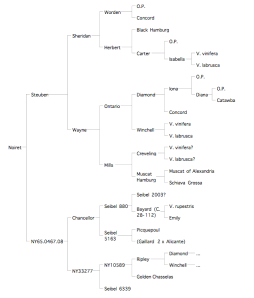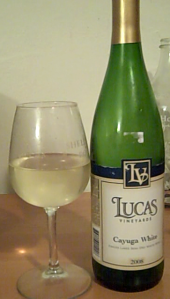Brewery Ommegang Witte

Style: Belgian-style Wheat Ale with Traditional Spices
Color (light, amber, or dark): Light
ABV: 5.1%
Price Point: $7.50/750 mL bottle
Closure: Cork with cage. The yeast sediment in the bottom is a clue that this bottle’s carbonation comes from a fermentation in the bottle, thus the need for the extra pressure protection of the champagne-style cork and cage.
Technical notes: From the website: “Witte is brewed with malted and unmalted wheat, barley malt, a light hops addition and spiced with sweet orange peel and coriander. Though adding a slice of citrus fruit is common while enjoying a wheat or Wiess [sic] beer, we feel that Witte’s gentle spicing and slight tartness renders the fruit superfluous.”
Hedonic notes: Pours with a lot of long-lasting foam. (Some people think that the foaminess of a beer is indicative of its quality. I’m not so sure, but that’s fodder for another post.) Smells of a little orange at first, giving way to some spicy, phenolic, medicinal tones and finally some plain old grain/malt. On the palate, tart, with lemon peel and tongue-numbing clove*. Very refreshing and light. After a long while, some curry appears on the finish. Likely a great summer beer (whoops, it’s definitely fall. Maybe this should have been on sale!) I agree with the brewery’s assessment that a slice of orange or lemon would be a bit much.
Rating: 



 2.5 out of 5 corks . It’s OK.
2.5 out of 5 corks . It’s OK.
Ithacork breaks into the world of beer (finally!). I don’t know how it took this long! The Ommegang Brewery in Cooperstown makes some quality Belgian-style beers. I’m not sure of their nationwide distribution, but around here, beers like Hennepin, Rare Vos, and Three Philosophers are ubiquitous. Cooperstown is a little over 2 hours east-northeast of Ithaca (and on the way to Boston). Maybe I will stop by the brewery on my next trip with Sarah out to Plymouth.
*Science!
One way that beer brewing is different from winemaking is that brewers have a seeming ability to throw all kinds of fruit, spices, or other stuff (coffee, pumpkin, jalapeño, etc.) into their product and still have it be called beer. However, spice aromas and flavors in beer don’t always come from the spice rack, the mysterious East, or the sandworms from Dune. In the case of most Belgian brews, the yeast can add a spicy character as well. The molecule I’m talking about here is 4-vinylguaiacol (4-VG). It’s one aroma component of cloves, (the major one is eugenol, found as a lignin degradation product in oaked wines, but not common in beer) and if you are old, you may have smelled it at the dentist’s office (clove oil has a slight analgesic effect, so it’s used as a numbing agent).

4-vinylguaiacol. Descriptors: clove-like, smoky, curry
Brewers are generally very protective of their yeast strains, and many breweries propagate their yeasts from previous batches. In this case, only certain strains of yeast (called Pof+, or “phenolic off-flavor” positive) have the ability (activity of the enzyme Pad1) to synthesize 4-VG and its counterpart 4-vinylphenol (medicinal/Band-aid) from hydroxycinnamic acid precursors. 4-VP and 4-VG are also the aroma precursors of {Brettanomyces} aroma compounds 4-ethylphenol and 4-ethylguaiacol in wines. (Van Beneden et al., “Formation of 4-vinyl and 4-ethyl derivatives from hydroxycinnamic acids: Occurrence of volatile phenolic flavour compounds in beer and distribution of Pad1-activity among brewing yeasts”, Food Chemistry, 2007).
Basically, Belgian witbiers and German hefeweizens have this clove aroma because of the strains of yeast that are traditionally used to ferment them. PS: The difference between a witbier and a weizen? Witbiers are often made with unmalted wheat, while weizens are made with malted wheat.






